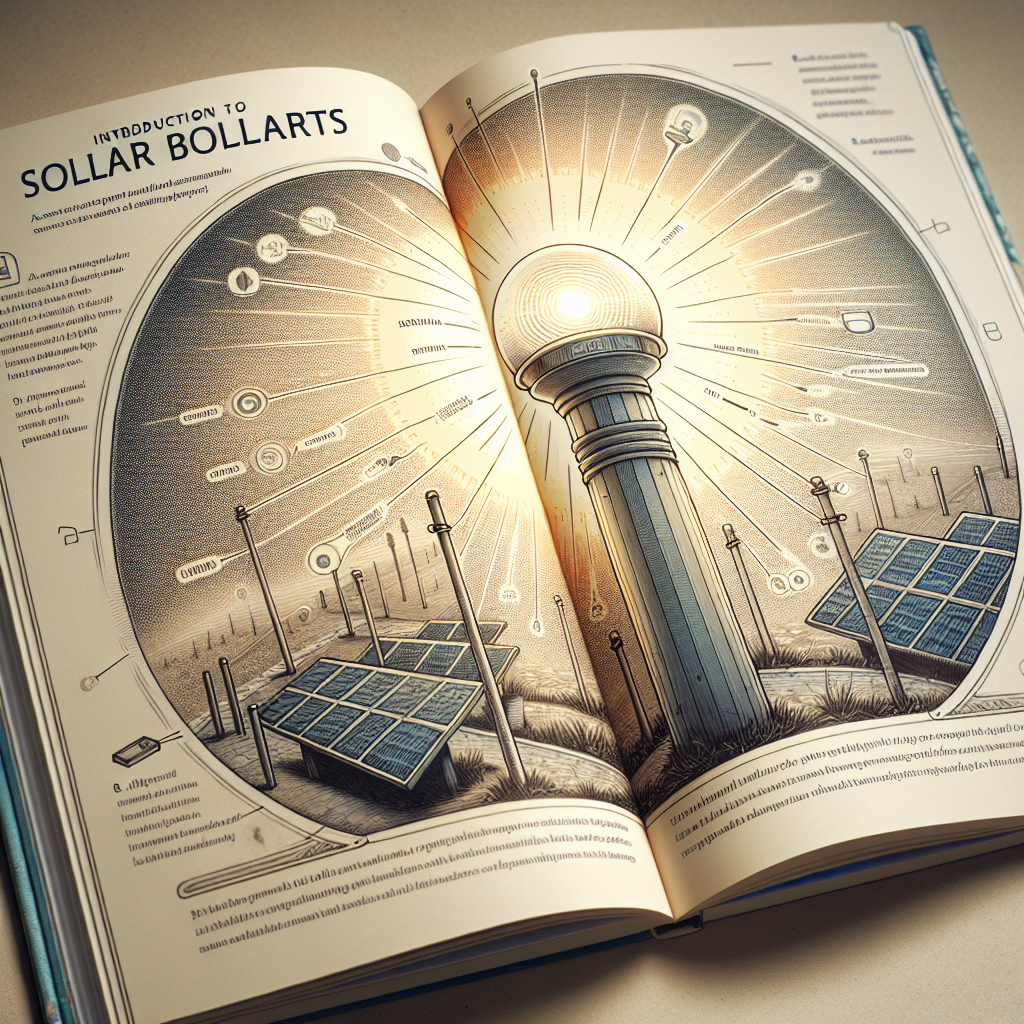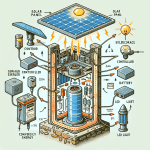Introduction to Solar Bollards
Table of Contents
Solar bollards are innovative outdoor lighting solutions that harness solar energy to provide illumination in various settings, such as pathways, gardens, parks, and commercial spaces. These self-contained units integrate solar panels, rechargeable batteries, and LED lights into a single, durable structure, offering an eco-friendly and cost-effective alternative to traditional wired lighting systems. By converting sunlight into electrical energy during the day and automatically activating at dusk, solar bollards ensure consistent, low-maintenance lighting while reducing energy consumption and minimizing environmental impact. Their ease of installation, coupled with advancements in solar technology and design, makes solar bollards an increasingly popular choice for enhancing safety, aesthetics, and sustainability in outdoor environments.
Benefits Of Using Solar Bollards In Urban Landscaping
Solar bollards, increasingly prevalent in urban landscaping, offer a multitude of benefits that extend beyond mere illumination. These innovative lighting solutions harness solar energy, providing an eco-friendly alternative to traditional electric lighting. As cities strive to become more sustainable, the integration of solar bollards into urban landscapes is a step forward in reducing carbon footprints and promoting environmental stewardship.
How Do Solar Bollards Improve Energy Efficiency?
One of the primary advantages of solar bollards is their energy efficiency. By utilizing solar panels to capture and convert sunlight into electricity, these bollards operate independently of the power grid. This autonomy not only reduces energy consumption but also lowers utility costs for municipalities and property owners. Furthermore, the reliance on renewable energy sources diminishes the demand for fossil fuels, thereby contributing to a reduction in greenhouse gas emissions. Consequently, solar bollards play a crucial role in mitigating climate change and fostering a greener urban environment.
What Are the Economic Advantages of Solar Bollards?
In addition to their environmental benefits, solar bollards offer significant economic advantages. The initial investment in solar bollards may be higher compared to traditional lighting systems; however, the long-term savings are substantial. Since solar bollards do not require electrical wiring, installation costs are considerably lower. Moreover, the maintenance expenses are minimal, as these bollards are designed to be durable and weather-resistant. The absence of ongoing electricity bills further enhances their cost-effectiveness, making them an attractive option for budget-conscious urban planners and developers.
How Do Solar Bollards Enhance Urban Aesthetics?
Beyond the financial and environmental aspects, solar bollards contribute to the aesthetic appeal of urban landscapes. Available in a variety of designs and finishes, they can seamlessly blend into different architectural styles and enhance the visual harmony of public spaces. The soft, ambient light emitted by solar bollards creates a welcoming atmosphere, improving the overall experience for pedestrians and visitors. This enhanced ambiance not only promotes a sense of safety and security but also encourages outdoor activities, thereby fostering a vibrant community life.
What Technological Features Make Solar Bollards Reliable?
Moreover, solar bollards are equipped with advanced technology that ensures reliable performance. Many models feature built-in sensors that automatically adjust the light intensity based on ambient conditions, optimizing energy usage and extending battery life. Additionally, the use of LED bulbs in solar bollards provides bright and consistent illumination while consuming minimal power. These technological advancements ensure that solar bollards remain functional even during cloudy days or extended periods of low sunlight, thereby guaranteeing uninterrupted service.
Where Can Solar Bollards Be Installed?
The versatility of solar bollards further underscores their value in urban landscaping. They can be strategically placed along pathways, in parks, around public buildings, and in parking lots to enhance visibility and guide pedestrians. Their application is not limited to public spaces; private properties, such as residential complexes and commercial establishments, can also benefit from the installation of solar bollards. This adaptability makes them a practical solution for a wide range of lighting needs, contributing to the overall safety and functionality of urban areas.
Why Should Cities Adopt Solar Bollards?
In conclusion, the benefits of using solar bollards in urban landscaping are manifold. Their energy efficiency, economic viability, aesthetic appeal, technological reliability, and versatility make them an ideal choice for modern cities aiming to achieve sustainability goals. As urban areas continue to grow and evolve, the adoption of solar bollards represents a forward-thinking approach to creating environmentally responsible and visually pleasing public spaces. By embracing this innovative lighting solution, cities can pave the way for a brighter, greener future.
How Solar Bollards Work: A Comprehensive Guide

Solar bollards are an innovative and environmentally friendly solution for outdoor lighting, combining functionality with sustainability. These devices harness solar energy to provide illumination, making them an ideal choice for pathways, gardens, parks, and other outdoor spaces. Understanding how solar bollards work involves delving into the components that make up these devices and the processes they undergo to convert sunlight into usable light.
What Role Does the Solar Panel Play in Solar Bollards?
At the core of a solar bollard is the solar panel, typically located at the top of the unit. This panel is composed of photovoltaic cells, which are responsible for capturing sunlight and converting it into electrical energy. The efficiency of this conversion process is crucial, as it determines how much energy can be stored and subsequently used for lighting. Modern solar panels are designed to maximize energy capture even in low-light conditions, ensuring that the bollards remain functional throughout varying weather patterns.
How Is Solar Energy Stored in Solar Bollards?
Once the solar energy is captured, it is stored in a rechargeable battery housed within the bollard. These batteries are usually lithium-ion due to their high energy density and long lifespan. The storage capacity of the battery is a critical factor, as it dictates how long the bollard can provide illumination during periods without sunlight, such as nighttime or cloudy days. Advanced solar bollards are equipped with energy management systems that optimize the charging and discharging cycles of the battery, thereby extending its operational life and ensuring consistent performance.
Why Are LEDs Used in Solar Bollards?
The stored energy is then used to power the light-emitting diode (LED) lights within the bollard. LEDs are chosen for their high efficiency and longevity, consuming significantly less power compared to traditional incandescent bulbs while providing bright and clear illumination. The design of the LED array within the bollard is also important, as it affects the distribution and intensity of the light. Many solar bollards feature diffusers or reflectors to ensure even light dispersion, enhancing visibility and safety in the illuminated area.
How Do Sensors Enhance the Functionality of Solar Bollards?
In addition to these primary components, solar bollards often incorporate sensors and control systems to enhance their functionality. For instance, many models are equipped with photoresistors or light sensors that detect ambient light levels. These sensors enable the bollards to automatically turn on at dusk and off at dawn, conserving energy and reducing the need for manual intervention. Some advanced models also include motion sensors, which activate the lights only when movement is detected nearby, further optimizing energy usage and extending battery life.
What Are the Maintenance Requirements for Solar Bollards?
The integration of these components and systems results in a self-sustaining lighting solution that requires minimal maintenance. However, it is important to consider factors such as the placement and orientation of the solar bollards to maximize their efficiency. Ideally, they should be installed in locations with ample sunlight exposure and minimal shading from trees or buildings. Regular cleaning of the solar panels is also recommended to ensure optimal energy capture.
Why Are Solar Bollards a Sustainable Lighting Solution?
In conclusion, solar bollards represent a sophisticated blend of technology and design, offering a sustainable and efficient alternative for outdoor lighting. By harnessing solar energy, storing it effectively, and utilizing it through efficient LED lights, these devices provide reliable illumination while minimizing environmental impact. As technology continues to advance, we can expect further improvements in the efficiency and functionality of solar bollards, making them an increasingly attractive option for a wide range of applications.
Installation And Maintenance Tips For Solar Bollards
Solar bollards are an increasingly popular choice for outdoor lighting, offering an eco-friendly and cost-effective solution for illuminating pathways, gardens, and public spaces. Their installation and maintenance, while relatively straightforward, require careful attention to detail to ensure optimal performance and longevity. This article provides essential tips for the installation and maintenance of solar bollards, guiding you through the process to achieve the best results.
To begin with, selecting the appropriate location for your solar bollards is crucial. These devices rely on sunlight to charge their batteries, so it is imperative to place them in areas that receive ample sunlight throughout the day. Avoid locations that are heavily shaded by trees, buildings, or other structures, as insufficient sunlight can significantly reduce the efficiency of the solar panels. Additionally, consider the purpose of the lighting and ensure that the bollards are positioned to provide adequate illumination for pathways or specific areas that require lighting.
Once you have identified the ideal locations, the next step is to prepare the installation site. This involves clearing the area of any debris, rocks, or vegetation that might obstruct the installation process. It is also advisable to mark the exact spots where the bollards will be installed, ensuring uniform spacing and alignment. Proper site preparation not only facilitates a smoother installation but also contributes to the overall aesthetic appeal of the lighting arrangement.
The actual installation process varies depending on the design and model of the solar bollards. Generally, it involves securing the bollard base into the ground, which can be done using ground spikes, concrete anchors, or other mounting hardware provided by the manufacturer. It is essential to follow the manufacturer’s instructions meticulously to ensure a stable and secure installation. For installations in areas with loose or sandy soil, additional measures such as using longer spikes or adding a concrete base may be necessary to prevent the bollards from tilting or becoming unstable over time.
After installation, regular maintenance is key to ensuring the longevity and efficiency of solar bollards. One of the primary maintenance tasks is cleaning the solar panels. Dust, dirt, and debris can accumulate on the panels, obstructing sunlight and reducing their charging capacity. Cleaning the panels with a soft cloth and mild detergent periodically can help maintain their efficiency. It is also important to inspect the bollards for any signs of damage or wear, such as cracks in the housing or corrosion on the metal parts. Addressing these issues promptly can prevent further deterioration and extend the lifespan of the bollards.
In addition to cleaning and inspections, battery maintenance is another critical aspect. Most solar bollards are equipped with rechargeable batteries that store energy collected by the solar panels. Over time, these batteries may lose their capacity to hold a charge and may need to be replaced. Monitoring the performance of the bollards and replacing the batteries as needed can ensure consistent lighting performance. It is advisable to use high-quality replacement batteries recommended by the manufacturer to achieve the best results.
In conclusion, the installation and maintenance of solar bollards are essential steps to ensure their effective operation and longevity. By carefully selecting the installation site, following proper installation procedures, and performing regular maintenance tasks, you can enjoy the benefits of sustainable and efficient outdoor lighting for years to come.
Read more about Solar Bollards:
- Introduction to Solar Bollards
- How Do Solar Bollards Work?
- Design and Aesthetics of Solar Bollards
- Maintenance and Durability of Solar Bollards
- Applications of Solar Bollards
- Choosing the Right Solar Bollard for Your Needs
- Installation and Wiring of Solar Bollards
- Integration of Solar Bollards with Smart Technology
- Comparison of Solar Bollards with Traditional Lighting Solutions
- Regulations and Standards for Solar Bollards








